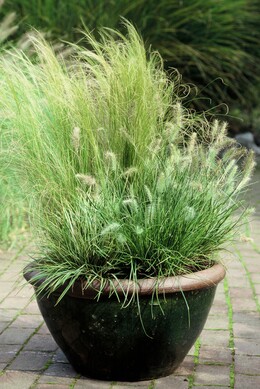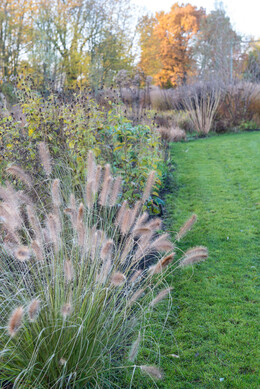In summer and autumn, the beautiful flower panicles of fountaingrass catch the eye, especially when the sun is shining through them. This perennial also has a lot to offer during the rest of the year: from its fresh budding leaf spikes in springtime to its fairytale winter silhouette. There is plenty of variety in shape and colour.
 A natural look
A natural look
Fountaingrass is originally native to warmer areas. Its Latin name is Pennisetum: penna means feather and sêta means brush. The flower spikes are grouped in pinnate brushes that grow from the grass clumps in the form of fountains, together with leaves. The flower colour ranges from silvery yellow and green to purple, and the leaf colour from fresh green to deep-dark red. With its natural look, this ornamental grass is an excellent fit for wilder and sleeker gardens alike.
 Practical tips
Practical tips
- Put these plants in a sunny, well-drained spot.
- Check the label for the height: it can vary from 40 centimetres to over 1.5 metres. Put the taller varieties more towards the back of the border.
- Combine fountaingrass with other perennials (Persicaria amplexicaulis, Gaura, Verbena bonariensis), plant it in groups, make a hedge or put them in ornamental pots.
- It is best to wait until spring to prune these plants back to 5 to 10 centimetres above the ground. In this way, you can enjoy the silhouettes all winter, while insects and small mammals find shelter there.
 A few favourites
A few favourites
There are 130 fountaingrass varieties, with Pennisetum alopecuroides the most common as a garden plant. Within this variety, ‘Red Head’ and ‘Hameln’ are richly flowering varieties with a soft brown to burgundy flower colour. Pennisetum x advena ‘Rubrum’ has stunning purple-red leaves, with gracefully curved purple-coloured flower spikes. Place it in a sheltered spot, for example near a wall, and cover well in winter as it is sensitive to frost. Pennisetum ‘Red Bunny Tails’ has stunning dark-red flower spikes. If you are looking to add some height to your garden, Pennisetum macrourum is perfect, with its long and light brown spikes. But there are many other varieties!
To view Pennisetum at Crocus click here
All images copyright iVerde ‘Perennial Power’
If you have enjoyed reading our blog post then why not fill in the form provided to allow us to send you our blog posts and newsletters by email. For all major gardening products, visit our shop from the menu above.

